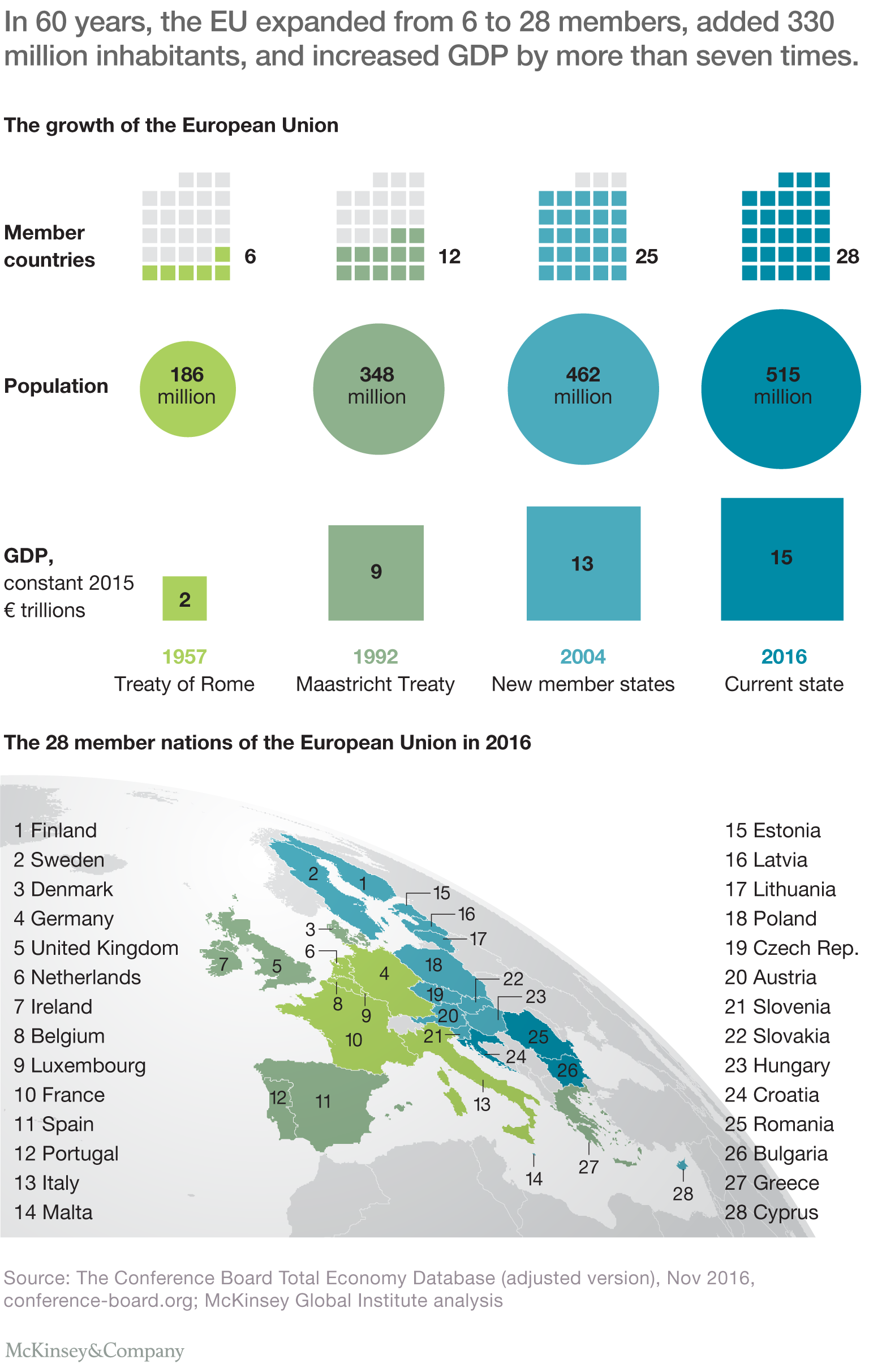Sixty years ago, on March 25, 1957, the heads of government of Belgium, France, Germany, Italy, Luxembourg, and the Netherlands met in Rome to sign the treaty establishing the European Economic Community, the forerunner of today’s European Union (EU). The document is explicit about its objectives: the preamble announces that the treaty will “lay the foundations of an ever closer union among the peoples of Europe” and improve living and working conditions through “common action to eliminate the barriers which divide Europe.”
Stay current on your favorite topics
This group expanded from six initial members to 28 countries with a combined population of more than 500 million and GDP of €15 trillion (exhibit). That makes the European Union the second-largest economic entity in the world after the United States, representing about one-fifth of global GDP. The customs union for the free circulation of goods that the accord set up now includes free movement of people, capital, and services. Living and working conditions have improved in ways the treaty signatories may not have imagined. The EU has also played an essential geopolitical role during its six decades, ensuring peace and stability among European neighbors that had spent previous centuries at war. And it has helped shore up young democracies in countries including Greece, Portugal, and Spain, as well as in the ten Eastern European nations that have joined since 2004.

Yet even for the most ardent advocates of European integration, the 60th anniversary of the treaty is a time of questioning and concern, not just celebration. The past decade has been an especially difficult and turbulent one—a time of weak economic growth, as the global financial crisis gave way to a sovereign-debt crisis, and of political fragility, as the EU’s reputation, achievements, and ability to act have been called into question. The British vote in June 2016 to leave the European Union has been the clearest manifestation of such doubts.
As it looks not just backward but forward, Europe will need to address the challenges posed by three global forces. First, aging will create an economic growth gap as the working-age population declines, putting the onus for future GDP growth on productivity, which is currently waning. Second, rapid advances in digitization and automation will disrupt the European economy, expose it to new competition, and raise difficult questions about the future of work, even as they provide the potential to boost productivity and close the growth gap created by the demographic changes. Third, the EU faces increasing competition from emerging-economy companies and digital multinationals, rising migration pressures, and a broader backlash against globalization and global institutions as many citizens feel left behind.

A window of opportunity for Europe
This discussion paper, Rome redux: New priorities for the European Union at 60, aims to provide a fact base and contribute to the ongoing debate about Europe’s past, present, and future. Drawing on research by the McKinsey Global Institute, we take a 60-year perspective that highlights the EU’s economic and social achievements as well as the global and internal forces that it must now contend with. We conclude by signposting some options for the EU and its members as they seek to adapt to changing times and construct a vibrant future. Whichever path they choose, success factors will include the EU’s ability to rekindle growth and build on its assets through new investment, leverage its scale by continuing to fill in the gaps in its single market, innovate to prepare for a changing world of work, and engage more deeply with citizens and new constituencies to shore up its legitimacy. To win over an increasingly skeptical European public, the EU will also need to form a new narrative about its aims and relevance in a rapidly changing world.


